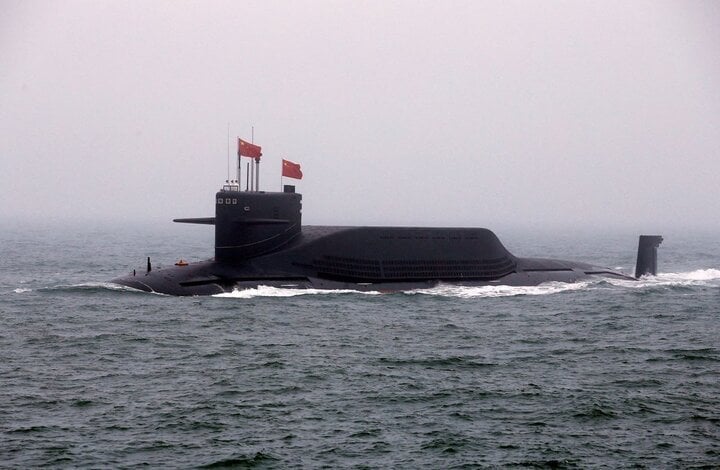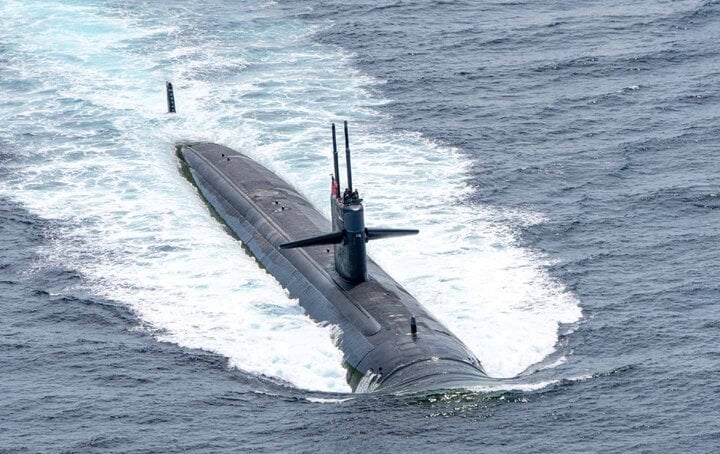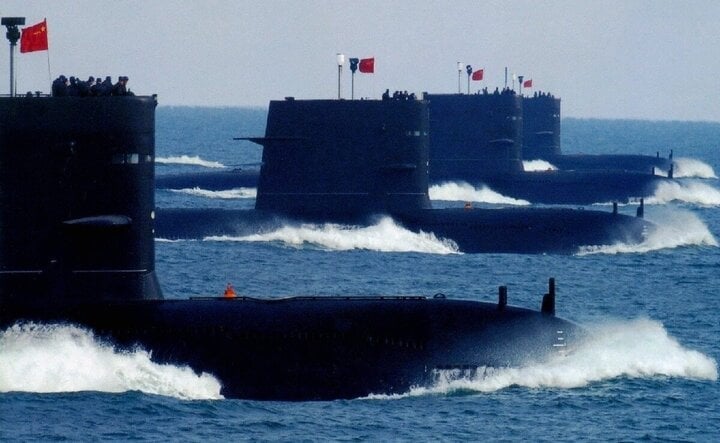According to The Wall Street Journal , the era of American nuclear submarine dominance over China is coming to an end. The Chinese navy's military and technological capabilities in submarine construction and anti-submarine warfare have now reached new heights. This change has even raised concerns that America's powerful fleets could be sunk in a military confrontation with China.
The Wall Street Journal cited reports on China’s scientific and industrial progress in naval warfare, pointing out that China is gradually “narrowing” the gap between it and the US in highly complex areas such as anti-submarine warfare submarine technology.
These developments not only threaten the Pentagon's regional strategy to contain China's navy in coastal areas but could also challenge US naval dominance globally in the long term.

Despite possessing fewer nuclear submarines, China could completely surpass the US in the next few years.
China builds submarines faster than the US
Earlier this year, a study by the China Maritime Studies Institute at the US Naval War College pointed to China's progress in developing nuclear reactors for use on its nuclear submarines, along with submarine propulsion systems.
Thus, Chinese nuclear submarines are now quieter and have a lower altitude than Russian nuclear submarines. This change makes Chinese submarines harder to detect than before.
Additionally, analysis of satellite images of the Huludao shipyard in Liaoning, northeastern China, taken last year shows that Beijing is building new nuclear submarines that are much larger than existing vessels.
The Wall Street Journal , citing leaked US Navy intelligence, reported that China’s impressive shipbuilding capacity will exceed 23.2 million tons per year by 2023, compared to about 100,000 tons per year for the US.
China's current shipbuilding pace allows it to produce many more warships at once, about 200 times the capacity of the United States.
Above all, the Chinese navy's construction of a vast underwater sensor network in China's coastal waters, dubbed the “Underwater Great Wall,” is giving Beijing a huge advantage.
The US Navy would certainly have difficulty deploying warships close to China if they entered waters where sensors were deployed.
The sensor network is not yet complete but will be operational soon. The system includes multiple passive and active sonar sensors, combined with unmanned surface and underwater vehicles that allow detection and monitoring of all vessel activities in the controlled area.

US submarines are no longer safe operating near the Chinese coast.
China is also said to be “getting better” at detecting US attack and cruise missile submarines that operate stealthily near its coast through other weapons systems.
In addition, the number of naval exercises between China and Russia is increasing. This not only enhances the Chinese navy's ability to coordinate with its northern neighbor in an emergency, but also allows them to learn from the Russian navy about how to operate as a global naval power that can compete with the United States.
“The implications of China’s naval development for the United States and its Pacific allies will be profound,” said former US Navy officer Christopher Carlson. He also said the US would have a headache in allocating resources to deal with new challenges from China.
Strategically, the Wall Street Journal noted, activities that the US once took for granted, such as the ability to approach coasts near China, will no longer be possible when Chinese nuclear-powered attack submarines can attack US warships by surprise.
Above all is the threat of Chinese submarine-launched ballistic missiles to the American homeland—a threat that Washington has long been accustomed to dealing with but has not yet experienced in its relationship with the Asian military superpower.
“Finding a submarine that operates quietly under the sea is extremely difficult, and China’s new nuclear submarines could be comparable to the Improved Akula class currently in service with the Russian navy,” Carlson added.
China’s 79-submarine fleet currently includes at least 16 nuclear-powered attack and ballistic missile submarines, including six Type 093 (NATO codename Shang-class) attack submarines and six Type 094 (NATO codename Jin) ballistic missile boats that “nearly continuously” patrol between Hainan Island and the South China Sea. But Carlson warned that the Asian nation could triple its current submarine-building rate to one to two submarines per year.

China's submarine power may have been exaggerated by the US as a way to increase the budget for building new nuclear submarines.
Expensive and difficult to build like an aircraft carrier
“Building nuclear submarines can be considered the pinnacle of technology in the economy and industry, only a few countries have mastered the technologies to do this. China now possesses submarine building technology that is not inferior to the US, Russia, the UK and France,” Russian military expert Vasily Dandykin analyzed.
According to Dandykin, there are several factors that have slowed the pace of new US submarine construction, starting with Washington’s decision to downsize its naval shipyards after the end of the Cold War. On the other hand, the Pentagon has also cut back on new nuclear submarines.
According to Dandykin, US nuclear submarine programs gradually lost their due attention after the collapse of the Soviet Union, and not only the US but also Europe was in a similar situation.
“The United States has the largest military budget in the world, far exceeding all other countries in the world. That means somewhere they have fallen into huge and expensive projects that do not fit their budget,” Dandykin said, citing the example of the $8 billion Zumwalt destroyer program that the US is implementing.
“There are many projects like Zumwalt that cost the US a lot of money. As a result, the US is now behind Russia in developing fourth-generation nuclear submarines, even though those designs date back to the Soviet era,” Dandykin stressed.
Regarding China's submarines, Dandykin points out that currently the bulk of China's fleet still consists of diesel-electric submarines, and it will take a lot of time and money for them to reach the same technological level as the US.
According to the estimate of a retired Chinese naval officer, China's ballistic missile nuclear submarines are mainly focused on second-generation vessels and the future goal is to develop third-generation vessels.
Dandykin believes that US efforts to hype the “Chinese threat” are “somewhat disingenuous” and are designed primarily to lobby for more resources to be allocated to US submarine building efforts because building a nuclear submarine fleet is much more expensive than building aircraft carriers both in terms of technology and budget.
Tra Khanh (Source: Sputnik, Wall Street Journal)
Source























































![[Maritime News] More than 80% of global container shipping capacity is in the hands of MSC and major shipping alliances](https://vphoto.vietnam.vn/thumb/402x226/vietnam/resource/IMAGE/2025/7/16/6b4d586c984b4cbf8c5680352b9eaeb0)










































Comment (0)